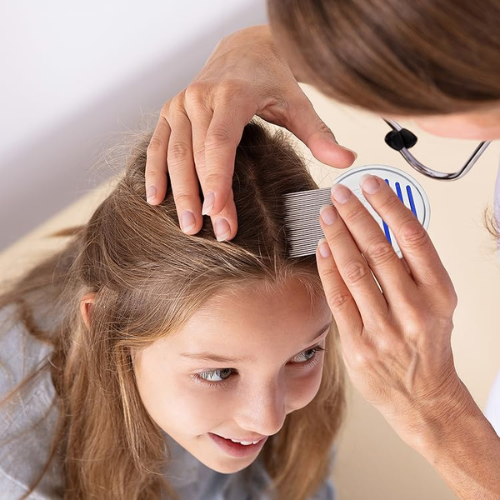If you've treated lice before and thought, "They just keep coming back," you're not alone. In 2025, more parents and schools are dealing with "super lice" - lice that are resistant to traditional treatments.
These tiny pests look identical to regular head lice but have developed genetic mutations that make them resistant to the most common over-the-counter lice shampoos and chemical treatments. Reports of super lice have been increasing across the U.S., Canada, and Europe since 2016, and by 2025, they've become the dominant strain in many regions.
What's driving this trend? Over time, lice exposed repeatedly to the same chemical ingredients - especially pyrethroids - evolved to survive them. Each new generation of lice becomes tougher, making old treatments far less effective.
Pesticide Resistance Explained: Why Old Treatments Fail
For decades, most lice products relied on pyrethrin or permethrin, insecticides derived from chrysanthemums. While effective in the past, overuse and incomplete treatments have allowed lice populations to adapt.
Here's how it happens:
- A treatment kills most lice, but a few survive because of a natural genetic mutation.
- Those survivors lay eggs, passing on their resistance.
- Over multiple cycles, resistant lice outnumber non-resistant ones.
Today, studies show that over 90% of lice populations in North America carry genes that help them survive chemical treatments. That's why even after using popular lice shampoos, families may still find live lice days later.
Unfortunately, increasing the dosage or using stronger chemicals isn't the answer - it can irritate the scalp and doesn't address the root problem. Instead, families are turning toward chemical-free, mechanical, and natural solutions that lice can't resist.
Signs You're Dealing with Resistant Lice
Wondering if you're facing super lice? Here are the telltale signs:
- ✓Lice remain alive after chemical treatment. You've followed all instructions, but lice keep crawling.
- ✓Itching continues for more than a week. Persistent itchiness means some lice or eggs survived.
- ✓You keep finding new nits (eggs). That's a sign of ongoing activity, not a completed treatment.
- ✓Multiple family members get lice again. Reinfection often means resistant lice weren't fully removed the first time.
If this sounds familiar, you're not doing anything wrong - it just means the lice you're battling have adapted. The good news? They can still be eliminated with the right approach.
Modern, Natural Alternatives That Work
Super lice might resist chemicals, but they can't resist being physically removed or smothered. Here are 2025's most effective, natural lice treatment methods:
1. Wet Combing (The Gold Standard)
Use a fine-tooth lice comb on wet hair with conditioner or an enzyme-based detangling spray. This physically removes live lice and nits. Do it daily for 7–10 days to break the life cycle.
2. Enzyme-Based Lice Treatments
New natural enzyme formulas dissolve the glue that holds nits to hair strands, making combing easier. They're safe, non-toxic, and effective on resistant lice.
3. Essential Oils
Certain oils - especially tea tree, neem, lavender, and eucalyptus - may repel lice and support treatment when used safely. Look for pre-formulated sprays or shampoos designed for children.
4. Heat Treatments
Professional lice clinics now use controlled warm air systems to dehydrate lice and eggs. It's chemical-free, safe, and often effective in one session.
5. Vacuum & Laundry Basics
While lice don't live long off the scalp, washing bedding, hats, and recently used clothing in hot water (above 130°F) helps prevent reinfestation.
When combined, these modern natural methods offer a comprehensive solution - one that lice can't evolve resistance to.
Expert Tips for Parents: Preventing Reinfestation
Beating super lice means breaking the cycle - not just killing what's visible. Try these expert-backed prevention tips:
- Check all family members. If one person has lice, everyone in the household should be examined.
- Repeat combing every few days for at least two weeks. Eggs hatch on a 7–10 day cycle.
- Clean personal items. Wash or seal hair accessories, brushes, and bedding used in the last 48 hours.
- Educate your child. Teach them to avoid head-to-head contact and not to share hats or headphones.
- Use preventive sprays with natural repellents before school or playdates.
Consistency is key. Missing even a few surviving nits can restart the entire infestation - so persistence pays off.
Summary & Call to Action
Super lice are proof that nature adapts - but with the right approach, you can stay ahead. Chemical shampoos may fail, but manual removal, enzyme-based products, and natural repellents still work reliably in 2025.
At Lice is Simple, we make it easy to identify, treat, and prevent super lice naturally. Explore our trusted guides, product recommendations, and DIY solutions to keep your home lice-free - no harsh chemicals required.
Because when it comes to lice, knowledge really is the best treatment.
